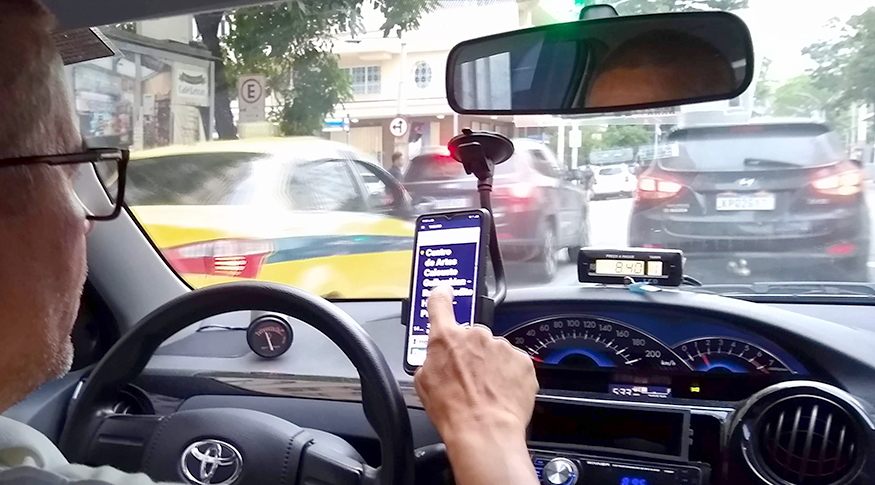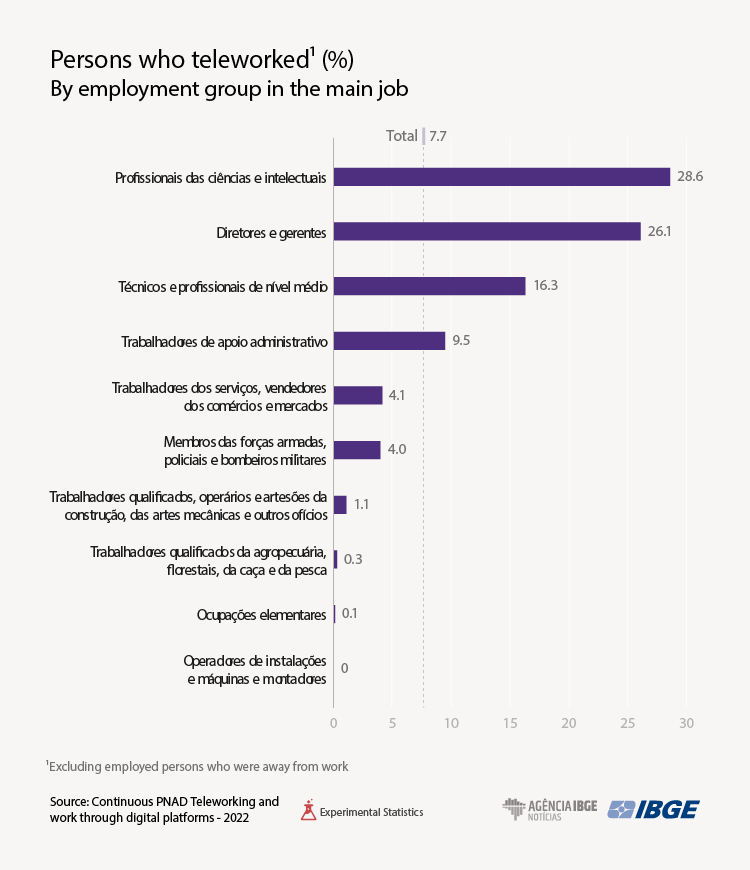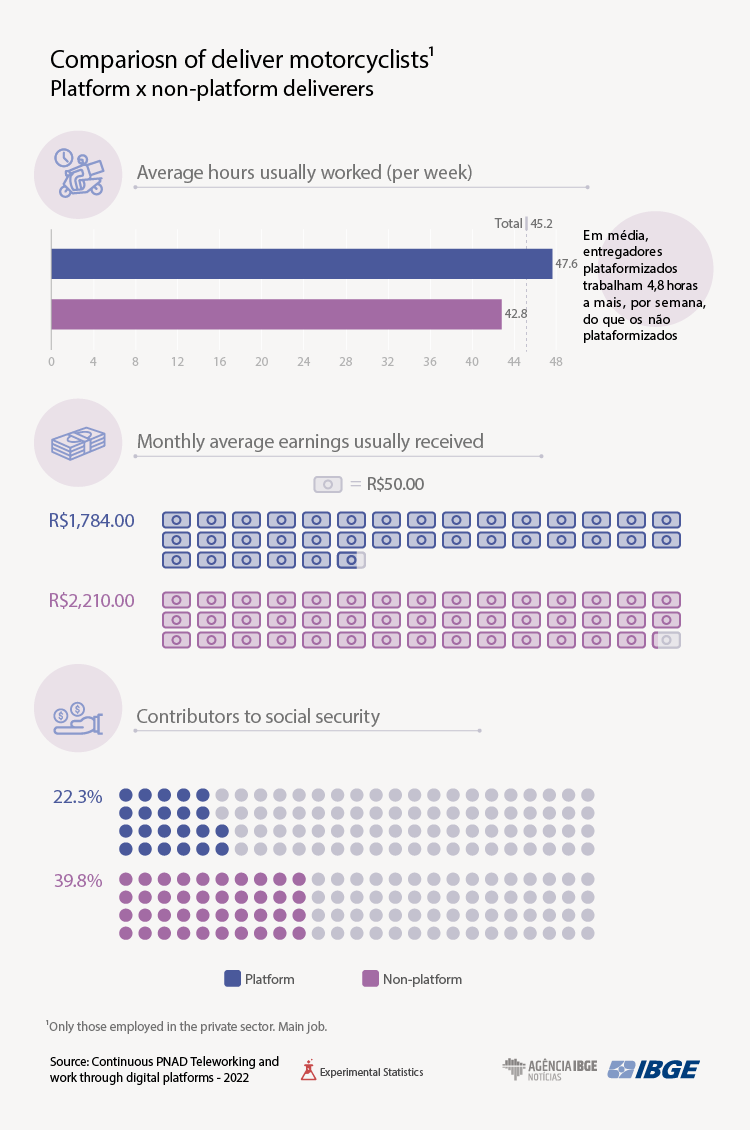Continuous PNAD
In 2022, 1.5 million persons worked through services applications in Brazil
October 25, 2023 10h00 AM | Last Updated: November 03, 2023 04h45 PM
Highlights
- In 2022, Brazil had 1.5 million persons working through digital platforms and services applications, the equivalent to 1.7% of the population employed in the private sector.
- Of this total, 52.2% (or 778 thousand) exerted their main job through ride-hailing applications in at least one out of two types listed (taxi or not).
- On the other hand, 39.5% (or 589 thousand) worked with delivery applications of food, products, etc., whereas those working with applications rendering services added up to 13.2% (197 thousand).
- The proportion of male platform workers (81.3%) was much higher than workers employed in the private sector (59.1%).
- Platform workers concentrated in the intermediate levels of schooling, mainly complete secondary education or incomplete higher education (61.3%).
- Nearly 77.1% of the platform workers are self-employed workers and 9.3% are employed in the private sector without a formal contract.
- In the fourth quarter of 2022, platform workers worked more weekly hours compared with the total number of persons employed in the private sector (46h x 39.6h) and counted with less workers contributing to social security (35.7% x 60.8%).
- The average earnings of workers through digital platforms with higher education (R$4,319) were lower than those of non-platform workers with the same schooling level (R$5,348).
- Compared with non-platform workers, motorcyclists of application delivery earned less (R$1,784 x R$2,210), had a lower proportion of contributors to social security (22.3% x 39.8%) and worked more weekly hours (47.6h x 42.8h).
- While 44.2% of those employed in the private sector were in the informality, that percentage among platform workers was 70.1%.
- Drivers of ride-hailing applications (excluding taxis) and application deliverers were highly dependent on the platforms: 97.3% and 84.3%, respectively. They claimed that the applications established the value to be received by each task and, for 87.2% and 85.3%, respectively, the applications established the clients to be attended.
- The data are from the unprecedented Teleworking and Work through Digital Platforms module of the Continuous National Household Sample Survey (Continuous PNAD). The statistics are experimental, i.e., they are in the test phase and under assessment.

In the fourth quarter of 2022, Brazil had 1.5 million people working through digital platforms and services applications. This figure represented 1.7% of the employed population in the private sector, which hit 87.2 million in that period. The data are from the unprecedented Teleworking and Work through Digital Platforms module of the Continuous National Household Sample Survey (Continuous PNAD), released today by the IBGE. The statistics are experimental, i.e., they are in the test phase and under assessment. The survey is the result of a Technical Cooperation Agreement with the State University of Campinas (Unicamp) and the Public Prosecutor´s Office of Labor (MPT).
Taking into account the type of application, 52.2% (778 thousand) exerted their main job through ride-hailing applications in at least one out of two types listed (taxi or excluding taxi). In a deeper view, 47.2% (704 thousand people) were those using private ride-hailing applications (excluding taxis) and 13.9% (207 thousand) using taxi applications.

On the other hand, 39.5% (589 thousand) worked with delivery applications of food, products, etc., whereas those working with applications rendering either general or professional services added up to 13.2% (197 thousand). “Concerning this division, it is important to highlight that a single person in their main job might answer that they work through more than one type of digital platform,” explains Gustavo Geaquinto, an analyst of the survey.
The North Region stood out with the highest proportion of workers through private ride-hailing applications (excluding taxis): they represented 61.2%, 14 percentage points (pp) more than the national average. That region also registered the lowest proportion of people working with applications of either general or professional services (5.6%), less than half of the Brazilian index. That type of application was concentrated in the Southeast, with 61.4% of the total number of workers employed in these platforms.
Most of the platform workers were men (81.3%), in a proportion much higher than the general average of workers employed in the private sector (59.1%). “There are more men among the platform workers because most of the application workers drive cars and motorcycles, which are mostly male jobs,” explained Gustavo Geaquinto.
The group aged between 25 and 39 years corresponded to nearly half (48.4%) of the persons working through digital platforms.
In terms of schooling, most platform workers had either complete secondary education or incomplete higher education (61.3%). That is the same bracket that leads the total number of employed persons (43.4%), though at a higher proportion among the platform workers. In contrast, the population either without any education or with incomplete primary education was the lowest one among the platform workers (8.1%), though it corresponded to 22.8% of the total number of employed persons.
Nearly 77.1% of the platform workers were self-employed workers, against 29.2% for those non-platform workers (29.2%). Among the groups of activity, 67.3% of the platform workers worked in Transportation, storage and mailing and 16.7%, in Lodging and food.
Platform workers work more hours and have a higher proportion of informality
In the fourth quarter of 2022, the monthly average earnings of the platform workers (R$2,645) were 5.4% higher than the average earnings of the total number of employed persons (R$2,513).
“Whenever comparing earnings of platform workers and non-platform workers, it is important to consider differences in terms of schooling level and job profile. For example, the share of persons with lower schooling levels and exerting elementary jobs among those non-platform workers is higher,” highlights Geaquinto.
For the two less educated groups, the real monthly average earnings of persons working through services applications exceeded more than 30% the earnings of those not using these digital tools. Among persons with complete higher education, the earnings of the platform workers (R$4,319) were 19.2% lower than of those not working through services applications (R$5,348).
This difference can be explained by the fact that a significant part of the platform workers with complete higher education exerts job that require lower skills levels, as the case of ride-hailing application drivers. “Among other reasons, this situation is due to the lack of job opportunities that best fit their skills,” explains the analyst.
On average, platform workers usually worked 46.0 weekly hours in their main job, more 6.5 hours than the other employed persons (39.5 hours). “The difference in the hours worked can explain the difference in earnings as well. If we consider earnings per hour worked, platform workers show, on average, earnings-hour below the other employed persons,” explains Geaquinto.
While 60.8% of those employed in the private sector contributed to social security, only 35.7% of the platform workers did that. At the same time, the proportion of informal platform workers (70.1%) was higher than that of the total number of persons employed in the private sector (44.2%).
Platform drivers work more hours per week
In the fourth quarter of 2022, 1.2 million persons employed as drivers of road transportation of passengers had this as their major activity. Of this total, 60.5% (721 thousand persons) worked with ride-hailing applications, including taxis, whereas 39.5% (471 thousand) did not use such applications. Earnings of platform drivers (R$2,454) were slightly higher than those of the non-platform drivers (R$2,412).

Like in the total number of platform workers, the average hours usually worked per week in the main job by application drivers (47.9 hours) also surpassed the average hours of those who did not work through ride-hailing applications (40.9 hours). “It is a difference of seven weekly hours or 17.1% more, whereas the difference in the average earnings was only 1.7% more. This results in a lower earnings/hour for platform workers,” explains the analyst. Earnings/hour of application motorcyclists were R$11.80, whereas that of motorcyclists not using applications were R$13.60.
Nearly 43.9% of non-platform passenger transportation drivers contributed to social security. Among those using applications, the percentage of contributors was 23.6%.

Among 338 thousand of motorcyclists in activities of mailing and delivery as their main job, 50.8% (171 thousand) worked through delivery applications. Unlike drivers, the average usual earnings of platform deliverers (R$1,784) represented only 80.7% of those received by non-platform workers (R$2,210). Platform deliverers worked more weekly hours (47.6 hours against 42.8 hours). “In other words, earnings/hour of platform deliverers (R$8.70) is also lower than those who do not work with applications (R$11.90),” explains Geaquinto.
Altogether, 39.8% of the non-platform motorcyclists contributed to social security, a proportion that falls to 22.3% among platform motorcyclists.
For Unicamp and MPT, statistics will help to foster discussion involving labor
This module of the Continuous PNAD is the result of a Technical Cooperation Agreement with the State University of Campinas (Unicamp) and the Public Prosecutor´s Office of Labor (MPT). For José Dari Krein, an economist and researcher at the Center for Union Studies and Labor Economy (Cesit) and a professor at the Unicamp´s Institute of Economics, the survey points out to a reality that is already being studied by researchers. “Speaking as a Unicamp professor and not on behalf of Unicamp, a situation has been created in which companies are able to hire a significant contingent of workers without recognizing their employment relationship. For that matter, this survey strongly adheres to the reality that we were already investigating, as workers controlled by digital platforms actually appear worse than the overall average of the labor market. Its data point out the urgency to rethink the society in a context of deep crisis against the need to undertake an ecological transition and to overcome a growing social inequality. We have to figure a society in which labor becomes central again, it becomes a factor of sociability and social organization, and not merely an instrumental strategy for people earning money to survive and pay their bills,” concludes him.
For prosecutor Clarissa Ribeiro Schinestsck, the uniqueness of the survey, though still in experimental character, represents an important step to subsidize the debate involving labor in digital platforms. “The survey strongly contributes to foster the public debate around the regulation of labor in digital platforms, even under the point of view of social security, which is only possible through official data. The statistics allow the creation of effective public policies and planning the operation of offices to protect decent labor, at the same time that they clearly demonstrate the informality in this type of work, the strong dependency of workers in relation to the platforms, longer shifts and lower earnings than ´non-platform´ workers of the private sector,” points her.
More about the survey
The unprecedented Teleworking and Work through digital platforms module of the Continuous National Household Sample Survey (Continuous PNAD) analyzes these new forms of work in Brazil in 2022. The data are analyzed by color or race, sex, age group, schooling level and employment type among other divisions. For more information, please access the complete publication and the support material.



















